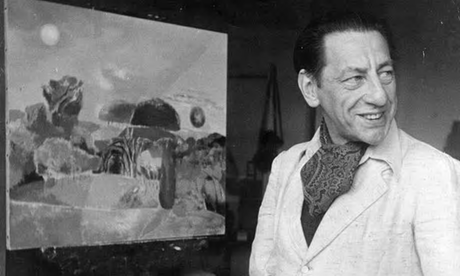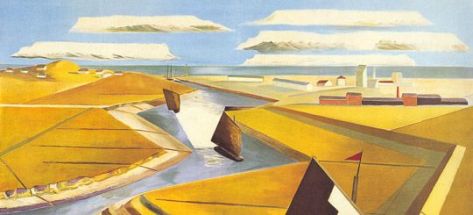


In the 3rd part of my review of British art I will be considering the important influence of Paul Nash who I have reviewed before and is featured in a exhibition at Tate Britain. His importance cannot be overstated as Frances Spalding recognises.
” One artist who played a significant role during the early 1930’s was Paul Nash. he first saw a substantial collection of contemporary French and Italian art while painting in Paris en route to Toulon”. [1].
” Aware of a trend towards abstraction he himself experimented with this style between 1929-1931 eventually realising that it was ill suited to his interests and temperament”. [2].
Spalding in her further commentary on Nash shows that he remained a Landscape painter of some importance.
” He remained primarily a landscape artist though he abstracted and remoulded nature according to his needs”.[3].
” The issue of abstract art grew more divisive as the decade progressed”. [4].







Spalding now discusses Unit 1 which was formed By Nash and others.
” It undermined abstraction the cohesiveness of unit one a group of 11 artists whose existence was announced by Paul Nash in a letter to the Times on 2nd June 1933″.[5].
” The 11 members included Nash , Moore Wadsworth , Coates Hepworth and Ben Nicholson , Burra and others”.[6].
Nicholson was responsible for the first abstract Exhibition which came to Britain.
” The same year saw the first abstract Exhibition in England. It was engineered by Ben Nicholson”. [7].
” It was during this decade that Ben Nicholson was able to concentrate in his art a number of crucial experiences. He had first recognised the abstract potential of colour in 1921 when on a visit to Paul Rosenberg’s gallery where he saw Picasso”.[8].






Concentrating on Nicholson Spalding continues with her commentary on his abstraction.
” In !924 and 1929 Nicholson produced canvasses that appear to be entirely abstract but it was not until the 1930’s that he progressed logically through an investigation of Cubism to a pure and substained abstract style”. [9].
” Nicholson and Hepworth were also given an introduction to Piet Mondrian (De styll Movement and Neo Plasticism) by Lazlo Mohology-Nagy at the (Bahaus). the experience of this white painted studio and of Mondrian’s paintings (Neo Plasticism)”. [10].
Nicholson was impressed by the mirror images displayed in Mondrian’s studio .
” Fascinated by the mirror image Ben Nicholson frequently used it in the early 1930’s to further his interest in shifting depth and ambiguous planar relationships”. [11].
” His use of line shape and colour like the mirror began to operate both as objects in their own rights and as illusion”. [12].



Nicholson was an idealist believing that freeing colour and form would lead to some form of abstract freedom.
” Nicholson believed that the liberation of form and colour achieved by abstract art paralleled or was linked to other forms of freedom”. [13].
” Hence the abstract works produced by Nicholson and Hepworth during the 1930’s have been seen to involve the very extinction of Englishness ( Whatever that means)”. [14]
” This opposition (Moore’s Figurative sculptures) has informed the post-war writing of both critics who accuse 20th century British artists of failing to match up to the bold avant-gardism of their continental or American Counterparts”.[15].
Barker in her essay comments on Unit 1 .
” At the same time Unit 1 needs to be seen as a strategic response to the difficult economic conditions in which artists found themselves in the early 1930’s”.[16].



Barker continues her comments about Nicholson and Hepworth during the 1930’s.
” During the mid-1930’s Nicholson and Hepworth both spent time in France where they met and visited a number of Important artists including Pablo Picasso, Hans Arp ( who when the Nazi’s invaded Paris would eventually move to the United States and have a very big influence on American art) Constantine Brancusi and Piet Mondrian”. [17].
” The growing commitment on the part of Nicholson and Hepworth to the practice of abstract art helped bring about the rapid demise of Unit 1″. [18].
This concludes my third part investigation into British art. in my concluding article I will deal with some of the social realists who emerged during the late 30’s like Percy Horton and Clive Branson and the influence of the Communist party on their work.
FOOTNOTES
- BRITISH ART SINCE 1900: FRANCES SPALDING .PG. 107
- DITTO.PG.107
- DITTO.PG.108
- DITTO.PG.108
- DITTO.PG.108
- DITTO.PG.109
- DITTO.PG.109
- DITTO.PG.109
- DITTO.PG.110
- DITTO.PG.110
- DITTO.PG.110
- DITTO.PG.110
- DITTO.PG.110-111
- ART OF THE AVANT-GARDES OPEN UNIVERSITY ABSTRACTION OF HEPWORTH AND NICHOLSON: EMMA BARKER . PG.273
- DITTO.PG.273
- DITTO.PG.275
- DITTO.PG.276
- DITTO.PG.276
Great work, Lawrence! –Paul
LikeLike